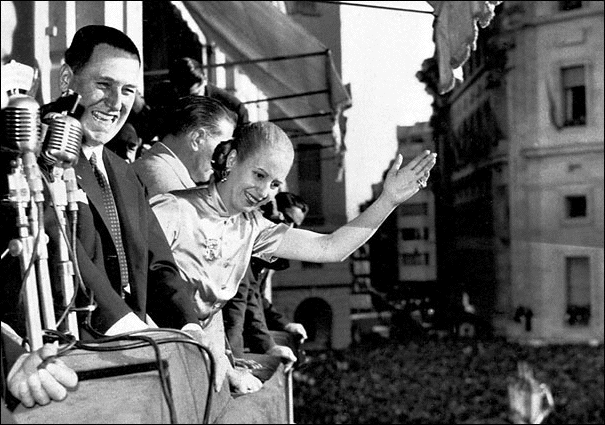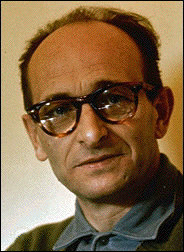.
Half-Century Later, a New
Look at Argentine-Nazi Ties
By LARRY ROHTER
April 4, 2005
BUENOS AIRES - That scores of
fugitive Nazis found their way to Argentina after World
War II, aided and abetted by Gen. Juan D. Perón,
is no secret. But according to a book just published here
that draws extensively on archival material only now
being made available to researchers, his government also
offered a haven for the profits of German companies that
had been part of the Nazi war machine and whose assets
the victorious Allies would otherwise have
seized.
|

|
.
|
|
A
new book argues that Juan and Evita
Perón, shown in 1950, benefited from
Argentina's relationship with Nazis and German
companies. [Associated
Press]
|
In "The German Connection: The Laundering of Nazi Money
in Argentina," Gaby Weber, a German journalist, argues
that the Perón dictatorship sponsored an operation
to move illicitly obtained wealth to Argentina and then
back to Germany. For nearly a decade, her book asserts,
German-made cars, trucks, buses and even the machinery
for entire factories flowed into Argentina, paid for with
dollars that were then used to help finance the "German
economic miracle."
To the chagrin of
Argentines who still revere him and his wife, Evita, the
evidence she presents indicates that Perón and a
few favorites around him also took a cut. But Ms. Weber,
who has lived and worked in South America since the
mid-1980's, said she was mainly interested in what she
described as two parallel but complementary money streams
to and from Germany, which were involved in and benefited
from the arrangement.
"One must make a
distinction between the Nazi Party organization and the
companies, which had no interest in financing a Nazi
resurgence," she said in a recent interview here. "My
focus is on the official Argentine government operation
to help those companies launder their money, but a lot of
Nazis also did it on their own, hoping to reconstruct the
party" from their hiding places here.
Ms. Weber's book,
published in German and Spanish, is based in part on
research in the corporate archives of Mercedes-Benz and
on interviews with Argentines and Germans who took part
in the scheme. But she also consulted government records
of Germany, the United States and, particularly,
Argentina, where she found transcripts of interrogations
of participants after Perón's ouster in September
1955, and other official documents that until now were
generally off-limits to researchers.
According to the documents
Ms. Weber cites, the laundering operation involved both
the consistent overcharging for goods exported from
Germany to Argentina and billing for nonexistent
transactions. But the Argentine Central Bank also
cooperated by permitting transactions to be conducted at
an exchange rate unusually favorable to German
companies.
"The German Connection"
focuses largely on Mercedes-Benz, the automobile, bus and
truck manufacturer that is today a unit of
Daimler-Chrysler. But others offered by Ms. Weber as
beneficiaries of the plan include German makers of
electrical and railway equipment and other capital goods,
as well as producers of items as varied as tractors and
television sets.
"It is impossible to
calculate the exact amount of money laundered in
Argentina between 1950 and 1955," Ms. Weber said. "But it
probably corresponds to well over a billion
dollars."
According to Argentine
documents seized after the overthrow of Perón,
about half of one large shipment of Mercedes sedans to
Argentina went directly to the president's office.
Perón appears to have kept four cars himself, but
sent the others to judges and prosecutors, politicians,
journalists and others whose support he was
seeking.
Ms. Weber also found
documentary evidence that in at least a couple of cases,
entire factories were shipped to Argentina for reassembly
here. Perón envisioned Argentina as an industrial
power and apparently saw the importing of German
equipment and experts as the best way to jump-start
aircraft, chemical and other industries.
"Most of the machinery
came from Rotterdam, though we don't know how it got
there," Ms. Weber said. She added that most of the
equipment appeared to be German in origin, though some
was probably looted from Czechoslovakia or other
conquered East European nations.
|

|
.
|
|
Adolf
Eichmann is said to have worked at an Argentine
factory. [Associated
Press, 1961]
|
At one point, Ms. Weber also maintains, the Nazi Adolf
Eichmann was hired, initially under his own name but
later under an alias, at the Mercedes-Benz plant in the
suburbs of the capital. In the interview, she suggested
that Mr. Eichmann, abducted by Israel in 1960 and then
tried and executed, might have functioned as a sort of
paymaster, "financing the movement and flight to
Argentina" of other fugitive Nazis.
Reached by telephone, a
spokesman for Mercedes-Benz, Ursula Mertzig, acknowledged
that Ms. Weber had been "given free entrance to our
archives in Stuttgart and that we checked the names she
gave us in our personnel data." But she described the
book as "a very strange story" that lacked
substantiation.
"She has no proof of money
laundering and there is no proof," Ms. Mertzig said. "We
could find nothing that gives nourishment to her
reproach. This is her idea of what history was, but it is
not supported by other historians in Germany."
The publication of Ms. Weber's
book follows the release here late last year of a
documentary film that caused debate on the same subject.
The film, "Nazi Gold in Argentina," contends that Swiss
banks, the Roman Catholic Church and Argentine
politicians conspired to loot hundreds of millions of
dollars in cash and other valuable assets held by the
Third Reich.
The film includes scenes of Nazi
submarines filled with gold bars unloading their treasure
on the deserted beaches of Patagonia, events that most
experts dismiss as fanciful. But it also sheds light on
the activities of shadowy figures like Hermann
Dörge, a German banker who worked in Argentina's
Central Bank during the 1940's and was officially
declared to have committed suicide after destroying
evidence of Nazi money transfers.
In his book "The Real Odessa:
Smuggling the Nazis to Perón's Argentina," the
Argentine writer Uki Goni documented how Croatian
fascists allied with the Nazis shipped over 500 pounds of
gold bars to Argentina after World War II. But he said
that "regarding German or Austrian Nazi money after the
war, the trail is more diffuse."
During the war itself, "there is
quite a lot of American documentation about how the Nazis
laundered money, seized from the banks of conquered
countries, in Argentina so they could buy raw supplies,"
Mr. Goni said in an interview. He added that he found it
"fishy" that many Argentine Central Bank records from
then and the postwar period were either incomplete or
said to be destroyed.
"I'm sure something happened,
but the documents are still hidden," Mr. Goni said. "A
tremendous amount of research still needs to be done, and
the Argentine government needs to open up more records,
especially those of state intelligence."
